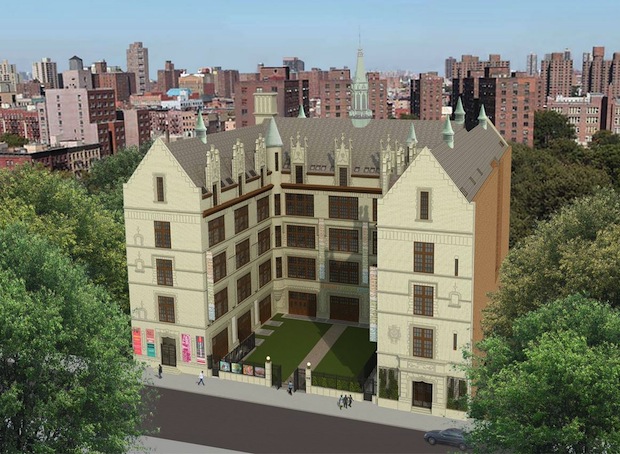
The site of proposed Live/Work units at El Barrio’s Artspace PS109 in Harlem (Image courtesy of Multi Housing News)
Like Mayor Bloomberg’s Spaceworks initiative, the artist studio-by-lottery program, Bill de Blasio has pieced together another plan to save the artists by building 1,500 new affordable live-work spaces for artists by 2024, part of his overall scheme to build or preserve 200,000 affordable units over the next ten years. As former senior planner in the Department of City Planning Tom Angotti has pointed out, the plan to simply continue building on top of the problems only exacerbates gentrification. “Affordable” units are often deregulated after they hit $2,500 in rent (as Manhattan has seen before), and the construction of affordable units often comes as part of the package with a new massive condo development (like Essex-Spura), which lead to rent raises in surrounding neighborhood. As Angotti argues repeatedly in his book “New York For Sale“, adding housing stock to the pot doesn’t solve underlying issues. Unless you’re creating a plan based on land ownership, not building usage (which is bought and sold and rezoned all the time), then you have little control over what happens on top of it.
All that aside, let’s do the math.
While it’s difficult to tally the total number of artists in the city, based on moving patterns and fuzzy definitions of creative work, full and off-time artists, and arts graduates versus non-BFA’eds, we do know that the 2000 census recorded a population of 132,900 artists in NYC. At a panel last month on Brooklyn Independent Media, Jamie Bennett of Artplace America (and former director of the NEA) said that a census conducted by the city five years ago (presumably 2010) showed an overall influx of artists each year, but a decrease of artists in their 30s to 50s, an age group typically starting families. We know the methodology is not perfect, but if there are enough artists to fill Bushwick, we can also safely assume that the numbers are in the tens of thousands.
So this population will be provided with 1,500 units over ten years– covering the kind of artists who’ve, say, been pushed out of their studios at Industry City. Bill de Blasio has since promised Industry City $100 million for development as a tech mecca/new “Chelsea Piers”. [Correction 2/3/2015: The administration is promising $100 million to the redevelopment of the nearby Brooklyn Army Terminal, for the stated purposes of preserving manufacturing jobs.] According to WNYC, the new artist units have been allotted a total of $3 million from the city, with $3 million from private foundations.
Then the overall goal to preserve 200,000 affordable residential units is also bullshit. Affordable to whom? A quick equation from the 2013 census:
- 2013: total population 8.4 million
- Median per capita income is $32K (2009-2013)
- Median household is $52K (2009-2013)
- Median rent as of December 2014:
- Manhattan: $3,836
- Brooklyn: $2,666.88
- Queens: $2,099
Now let’s be generous and assume that each apartment is split by an average of 2 unwedded childless individual earners, making $32K each, and everyone moves to Queens, which means each person pays rent of $1,049/month.
If you assume that 70% of your income is take-home, your grand total = $22,400, or $1,866/month.
This leaves millions of renters with an average extra earning of $817 per month. Minus a $112 monthly Metrocard, that leaves you with $705 for utilities, Internet, and groceries. This alots a middle class person $22 per day in the most expensive city in the country. 200,000 affordable “preserved or new” units over ten years is not even a drop of a drop in the ocean.


{ 2 comments }
This is a really good takedown/breakdown, though given how many artists are freelancers, health insurance needs to come out of that $705. So at roughly 300-400 per month for even remotely reasonable, self-paying insurance for a 30 – 50 something artist…
Good point! There’s always Medicaid. It’s awful and covers nothing, but I’m in my 20s and don’t have kids.
Comments on this entry are closed.